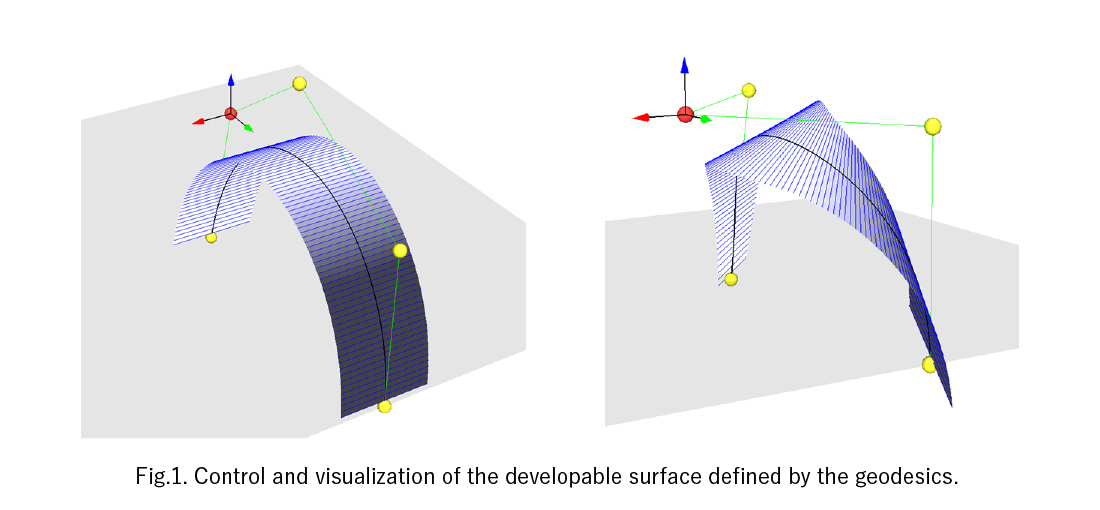Research Contents
Mitani Group
TitleDesign of developable shapes with folding along the space curves
Research items
We develop the discrete representation method and the interactive design method of the shapes with “folds,” which are the essential elements in the origami studies. We also model the transition process of the folds from the developed state to the final folded state. Further, we analyze the transition process of the folds from the viewpoint of the degeneration and type change of the structural equation of the surface.
- Discrete representation and interactive design method of the developable shapes with folds.
We develop the discrete representation method of the geometric shapes with folds arising by folding the surface and its interactive design method. We develop a technique combining the method to specify the angle of the folding and the folds explicitly and method to specify the normal map by using the images by Maekawa Group. - Modeling of the transition process of the folds from developed state to the final folded state. We develop a method to model the transition of states from the flat state of material to the solid folded state represented by (1) according to the change of the angle of folding at the folds. We also quantify the distance between the modeled shape and theoretical developable surface model and develop the method to visualize it.
- Continuous deformation and Klein geometric analysis
The developable surfaces allow parametric representation by the special coordinate system called the isothermic coordinates. We investigate by using the computer simulation the degeneration of the solutions of the structural equation (Gauss-Codazzi equation) expressed by the isothermic coordinates at the folds. We then describe the transition process in (2) analytically. At the same time, we investigate it from the viewpoint of Klein geometries.
Outline
- When we define a fold by a space curve and the folding angle along the curve, a solid shape is formed by this curve and two surface areas adjoining at the curve. Each of the two surfaces must be developable surface, and they should be connected without any gap after being developed on the flat plane. Therefore, how to design the shapes under such geometric constraints is a problem. From the viewpoint of differential geometry, the folds may be regarded as the undifferentiable singularities. We model the shapes taking such properties into account and develop the interactive design method to obtain the desired shape quickly. We also implement the interactive manipulating method in the system. We then incorporate the space curve defining the fold and folding angle, specification of folding curves (plane curves) in the developed state on the flat plane, and the confirmation of the obtained shapes in the design process.
- We consider the three-dimensional shapes formed by the planar folds given as inputs in shape design in 1 and the folding angle. We visualize the transition process from the flat state to the three-dimensional shapes by using the model reconstruction by using the folding angles as the parameters, with the aid of the real algebro-geometric methods. However, there may be the case where the path from the flat state to the solid-state preserving the developability does not exist. Therefore, we use the approximated developable surface model in the deformation process, allowing the error. Also, we realize the estimation of the strain in the production process and its optimization by defining the distance function between the approximate and original developable surface models.
- We investigate the surfaces with folds from the viewpoint of the structural equation (Gauss-Codazzi equation), and analyze the behavior of the solutions around the singularities (folds) to describe the transition process in 2 analytically. We apply the method of Klein geometry developed by Miura Group to the developable surface. Concretely, we describe the deformation of the developable surface by the Laguerre geometry and Lie sphere geometry. By considering the surface area minimization problem in those geometries, we generate the family of surfaces connecting the minimal surfaces and the developable surfaces.
Placement in the project
- We investigate the surfaces with folds from the viewpoint of the structural equation (Gauss-Codazzi equation), and analyze the behavior of the solutions around the singularities (folds) to describe the transition process in 2 analytically. We apply the method of Klein geometry developed by Miura Group to the developable surface. Concretely, we describe the deformation of the developable surface by the Laguerre geometry and Lie sphere geometry. By considering the surface area minimization problem in those geometries, we generate the family of surfaces connecting the minimal surfaces and the developable surfaces.
- It is crucial in the production process to know the deformation process from the initial state of the material (the state where the folds are manufactured to be flat) to the final shape of the product. Since the shapes arising during this process are not necessarily represented as the developable surfaces, we adopt the approximate developable surface model allowing the errors, which is developed by Kajiwara and Ohsaki Groups. We then visualize the strain and stress arising in the materials.
- The intermediate class of surfaces between the developable surfaces and the minimal surfaces is ambiguous, and there is no guiding principle to specify them. We use the idea of Klein geometry to generate the class of surfaces by crossing the border of the Euclid geometry. Our research is placed to be essential to generate the family of surfaces required by Ohsak and Honma Groups. This method also directly connected to the surface generation of Miura and Maekawa Groups.



 Return to Top Page
Return to Top Page